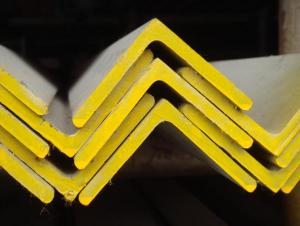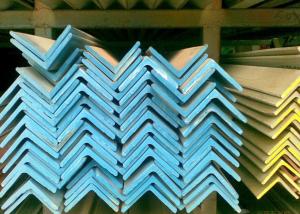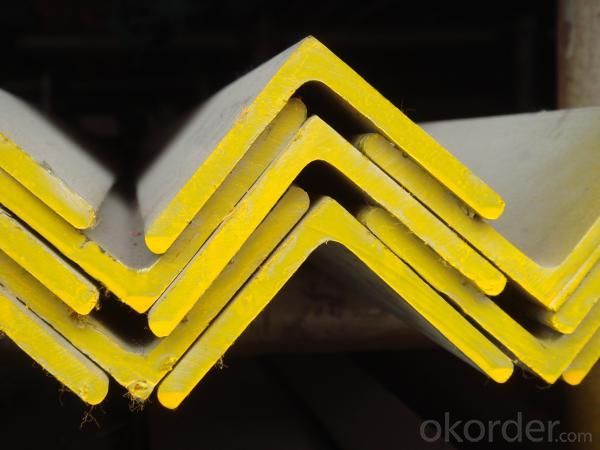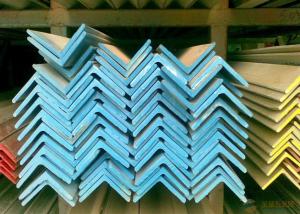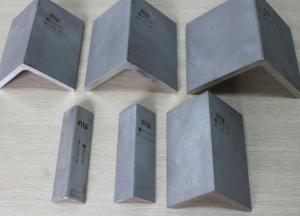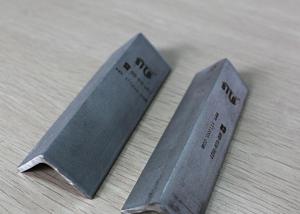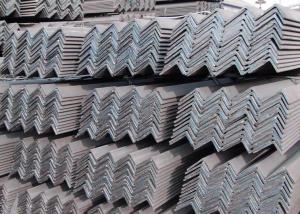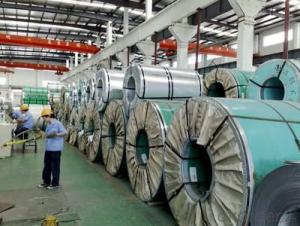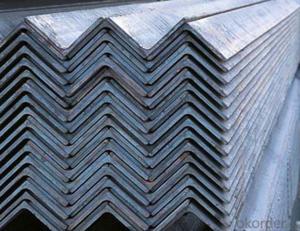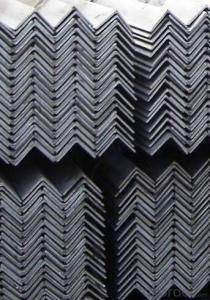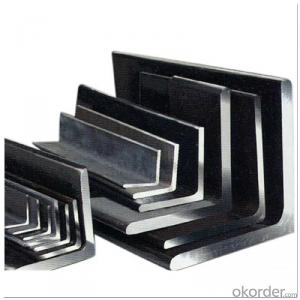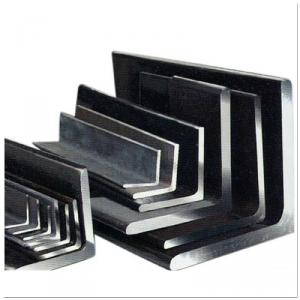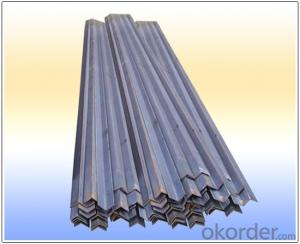Best Quality for Stainless Steel Angle Bar
- Loading Port:
- China Main Port
- Payment Terms:
- TT or LC
- Min Order Qty:
- 1 Ton m.t.
- Supply Capability:
- 500 Tons Per Month m.t./month
OKorder Service Pledge
OKorder Financial Service
You Might Also Like
General Informaiton of Stainless Steel Angle Bar
1. Grade: SS200, 300,400 series
2. Size: 25×25×3 mm-100×100×10mm
3. Process: HRAP
4. Length: 2-6m
5. Shape: Equal
6. Delivery: within 20 days
7. MOQ: 1 ton
8. Certificate: ISO 9001:2008, SGS
9. Package: Standard Export Packing, or put into wooden boxes according to your requirement
10. Application: Construction, Marine, Industry etc.
Specification of Stainless Steel Angle Bar
Name | Stainless Steel Angles | |||||
Standard | ASTM A554, A312, A249, A269 and A270 | |||||
Material Grade | 304,316,201,202, 316L,430 | |||||
Length | 6m or as customers' request | |||||
Tolerance | a) Thickness: +/-0. 15mm | |||||
b) Length: +/-4. 5mm - 0mm | ||||||
Surface | 180G, 320G, 400G Satin / Hairline(Matt Finish, Brush, Dull Finish) 400G, 500G, 600G or 800G Mirror finish | |||||
Application | Decoration construction, upholstery, industry instruments | |||||
Test | Squash test, Extended test, Water pressure test, Crystal rot test, Heat treatment, NDT | |||||
Chemical Composition of Material | Composition Material | 201 | 202 | 304 | 316 | 430 |
C | ≤0.15 | ≤0.15 | ≤0.08 | ≤0.08 | ≤0.12 | |
Si | ≤1.00 | ≤1.00 | ≤1.00 | ≤1.00 | ≤1.00 | |
Mn | 5.5-7.5 | 7.5-10 | ≤2.00 | ≤2.00 | ≤1.00 | |
P | ≤0.06 | ≤0.06 | ≤0.045 | ≤0.045 | ≤0.040 | |
S | ≤0.03 | ≤0.03 | ≤0.030 | ≤0.030 | ≤0.030 | |
Cr | 16-18 | 17-19 | 18-20 | 16-18 | 16-18 | |
Ni | 3.5-5.5 | 4-6 | 8-10.5 | 10-14 | ||
Mo | 2.0-3.0 | |||||
Mechanical Property | Material Item | 201 | 202 | 304 | 316 | |
Tensile Strength | ≥535 | ≥520 | ≥520 | ≥520 | ||
Yield Strength | ≥245 | ≥205 | ≥205 | ≥205 | ||
Extension | ≥30% | ≥30% | ≥35% | ≥35% | ||
Hardness (HV) | <253 | <253 | <200 | <200 | ||
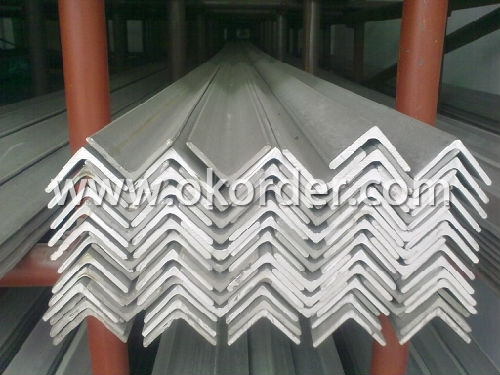
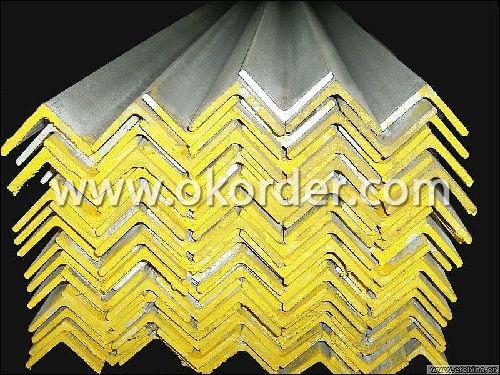
- Q: Can stainless steel angles be used in the production of outdoor sports equipment?
- Yes, stainless steel angles can be used in the production of outdoor sports equipment. Stainless steel is known for its durability and resistance to corrosion, making it an ideal material for outdoor applications. Stainless steel angles can be used to provide structural support and stability in various types of outdoor sports equipment, such as goal posts, basketball hoops, and outdoor fitness equipment. Additionally, stainless steel's aesthetic appeal and low maintenance requirements make it a popular choice for outdoor sports equipment that needs to withstand harsh weather conditions and heavy use.
- Q: How do stainless steel angles perform in corrosive gas environments?
- Stainless steel angles demonstrate remarkable resistance to corrosion in various environments, including those with corrosive gases. The presence of chromium in stainless steel forms a thin layer of passive oxide on the surface, which serves as a protective barrier against corrosion. This oxide layer remains stable and self-repairs, offering exceptional resistance to gases like sulfur dioxide, hydrogen sulfide, and chlorine. When it comes to corrosive gas environments, stainless steel angles outperform other materials, displaying excellent resistance to pitting corrosion, stress corrosion cracking, and general corrosion. This makes them the preferred choice in industries such as chemical processing, petrochemical, oil and gas, and marine. The specific grade of stainless steel used in the angles also significantly affects their performance in corrosive gas environments. Grades such as 316 and 304 stainless steel are commonly used due to their high resistance to corrosion. These grades contain additional elements like molybdenum, which further enhances their ability to withstand corrosive gases. Nevertheless, it is important to remember that even stainless steel angles can be vulnerable to corrosion under extreme conditions. Factors like extreme temperatures, high concentrations of corrosive gases, or prolonged exposure to aggressive chemicals can potentially impact their performance. Therefore, it is crucial to carefully select the appropriate grade of stainless steel and maintain and clean them properly to maximize their resistance to corrosion in gas environments.
- Q: What is the difference between 304 and 316 stainless steel angles?
- The main difference between 304 and 316 stainless steel angles lies in their composition and the presence of certain elements. 304 stainless steel is a versatile and widely used stainless steel alloy that contains chromium and nickel. It is known for its excellent corrosion resistance, high durability, and ease of fabrication. However, 304 stainless steel angles are not as resistant to corrosion as 316 stainless steel angles in certain environments, such as marine or highly corrosive settings. On the other hand, 316 stainless steel angles are a higher grade alloy that contains additional elements, such as molybdenum, which enhances their corrosion resistance. This makes them particularly suitable for applications where exposure to chloride-based substances, acids, or high salinity is expected. 316 stainless steel angles are commonly used in marine environments, chemical processing plants, and medical equipment. In terms of appearance, both 304 and 316 stainless steel angles have a similar look and finish. However, 316 stainless steel angles may have a slightly higher luster due to the presence of additional elements. To summarize, while both 304 and 316 stainless steel angles offer good corrosion resistance and durability, 316 stainless steel angles are better suited for applications where higher levels of resistance to corrosion and pitting are required, especially in harsh or corrosive environments.
- Q: What are the mechanical properties of stainless steel angles?
- Stainless steel angles possess several important mechanical properties that make them highly versatile and suitable for various applications. Firstly, stainless steel angles have excellent strength and durability. This is due to the high content of chromium in stainless steel, which enhances its corrosion resistance and provides superior strength compared to other materials. The strength of stainless steel angles allows them to withstand heavy loads and pressure, making them ideal for structural applications. Secondly, stainless steel angles exhibit good ductility. Ductility refers to the ability of a material to be stretched or bent without breaking. Stainless steel angles can be easily formed into different shapes or angles without losing their structural integrity. This characteristic makes them highly adaptable and easy to work with in various fabrication processes. Thirdly, stainless steel angles possess excellent toughness. Toughness refers to a material's ability to absorb energy and resist fracture or cracking under impact or sudden loading. Stainless steel angles exhibit high toughness, making them resistant to damage or deformation even under extreme conditions. This property is particularly important in applications where the angles may be subjected to heavy impacts or vibrations. Additionally, stainless steel angles have good thermal conductivity. This property allows them to effectively distribute heat, making them suitable for applications where thermal management is crucial. Stainless steel angles can efficiently transfer heat away from sensitive components, ensuring the longevity and performance of the overall system. Lastly, stainless steel angles have excellent corrosion resistance. The high chromium content in stainless steel forms a passive protective layer on the surface, which prevents oxidation and corrosion. This property allows stainless steel angles to be used in environments with high moisture, corrosive chemicals, or extreme temperatures without significant degradation. In summary, stainless steel angles possess a range of mechanical properties including strength, ductility, toughness, thermal conductivity, and corrosion resistance. These properties make stainless steel angles ideal for a wide range of applications such as construction, industrial machinery, automotive, and marine industries.
- Q: How do stainless steel angles resist corrosion?
- The unique composition and protective oxide layer of stainless steel angles allow them to resist corrosion. Stainless steel angles mainly consist of iron, combined with elements like chromium, nickel, and molybdenum. Among these elements, chromium is especially important for corrosion resistance. When stainless steel angles come into contact with oxygen, a thin layer of chromium oxide forms on the surface, which is invisible. This oxide layer acts as a barrier, preventing oxygen from reaching the underlying metal and stopping the corrosion process. If the passive layer is damaged or removed, it will naturally reform when exposed to oxygen again. Stainless steel typically contains at least 10.5% chromium, which enables it to resist corrosion in different environments, including harsh conditions like high humidity, saltwater, and chemical exposure. The addition of other elements like nickel and molybdenum further enhances the corrosion resistance of stainless steel angles. Apart from their composition, stainless steel angles possess other factors that contribute to their corrosion resistance. They have a smooth surface that prevents the accumulation of dirt, moisture, and other corrosive substances. Additionally, stainless steel angles have excellent mechanical properties, including high strength and ductility, making them resistant to deformation and cracking under stress. In conclusion, the corrosion resistance of stainless steel angles is due to their composition, especially the presence of chromium and the formation of a protective oxide layer. This oxide layer acts as a barrier against further corrosion, and the self-repairing nature of stainless steel ensures its long-term resistance to corrosion in various environments.
- Q: How do stainless steel angles perform in coastal environments?
- Stainless steel angles are highly resistant to corrosion and are therefore well-suited for use in coastal environments. The high levels of chromium present in stainless steel alloys create a passive protective layer on the surface of the metal, which helps to prevent corrosion and rust formation. This passive layer acts as a barrier against the corrosive effects of saltwater, humidity, and other coastal elements. This corrosion resistance makes stainless steel angles ideal for applications such as coastal construction, marine equipment, and installations near saltwater bodies. They can withstand prolonged exposure to saltwater spray, moisture, and high levels of humidity without deteriorating or losing their structural integrity. Additionally, stainless steel angles are also resistant to pitting and crevice corrosion, which are common issues in coastal environments. The added resistance to these forms of corrosion further enhances the performance and longevity of stainless steel angles in such settings. Furthermore, stainless steel angles are known for their strength and durability. They can withstand the harsh conditions associated with coastal environments, including strong winds, saline air, and abrasive particles carried by the wind. This inherent strength ensures that the angles maintain their structural integrity and do not deform or fail under these conditions. In summary, stainless steel angles perform exceptionally well in coastal environments due to their high corrosion resistance, strength, and durability. They are able to withstand the corrosive effects of saltwater, humidity, and other coastal elements, making them a reliable choice for a wide range of applications in these settings.
- Q: How do you calculate the moment of inertia for torsion of a stainless steel angle?
- The moment of inertia for torsion of a stainless steel angle can be calculated using the formula: I = (b * h^3) / 12 Where: - I is the moment of inertia - b is the width of the angle - h is the height of the angle This formula assumes that the angle is uniform in thickness and has a rectangular cross-section.
- Q: What are the different ways to join stainless steel angles?
- Depending on the desired strength of the joint and the specific application, there are various ways to connect stainless steel angles. Welding, bolting, adhesive bonding, and mechanical fastening are some common methods. 1. To create a strong and permanent joint suitable for structural applications, stainless steel angles can be joined through welding. TIG, MIG, or spot welding techniques can be used. However, this method requires skilled labor and specialized equipment. 2. If adjustability or flexibility is required, bolting is a suitable method. Stainless steel angles can be connected using bolts, nuts, and washers. This allows for easy disassembly and reassembly when necessary. 3. For a clean and visually pleasing joint without visible fasteners, adhesive bonding can be used. Industrial-grade adhesives are used to bond the stainless steel angles together. This method is particularly useful when welding or drilling holes is not feasible or desired. 4. Mechanical fastening techniques such as riveting or clinching can also be used to join stainless steel angles. Riveting involves using a rivet gun to secure the angles with a rivet, while clinching deforms the material to create a permanent joint. Mechanical fastening is a versatile method suitable for various applications. When selecting the appropriate method, it is important to consider factors such as load-bearing capacity, corrosion resistance, and aesthetic requirements. Seeking advice from a professional or engineer is recommended to ensure the chosen method meets the specific project needs.
- Q: Can stainless steel angles be used in construction?
- Yes, stainless steel angles can be used in construction. They are commonly utilized for structural support, framing, and reinforcement in buildings, bridges, and other structures due to their high strength, durability, and corrosion resistance properties.
- Q: Can stainless steel angles be used in the production of power generation equipment?
- Yes, stainless steel angles can be used in the production of power generation equipment. Stainless steel is known for its high strength, corrosion resistance, and durability, making it suitable for various applications in the power generation industry. It is commonly used in the fabrication of turbines, generators, and other critical components due to its ability to withstand high temperatures, pressures, and harsh environments.
1. Manufacturer Overview
| Location | Jiangsu,China |
| Year Established | 2002 |
| Annual Output Value | Above US$ 8 Million |
| Main Markets | China, East Asia, |
| Company Certifications | ISO9001:2000; |
2. Manufacturer Certificates
| a) Certification Name | |
| Range | |
| Reference | |
| Validity Period |
3. Manufacturer Capability
| a) Trade Capacity | |
| Nearest Port | Shanghai |
| Export Percentage | 40% |
| No.of Employees in Trade Department | 30 People |
| Language Spoken: | English;Chinese |
| b) Factory Information | |
| Factory Size: | Above 26,000 square meters |
| No. of Production Lines | Above 6 |
| Contract Manufacturing | OEM Service Offered;Design Service Offered |
| Product Price Range | Average |
Send your message to us
Best Quality for Stainless Steel Angle Bar
- Loading Port:
- China Main Port
- Payment Terms:
- TT or LC
- Min Order Qty:
- 1 Ton m.t.
- Supply Capability:
- 500 Tons Per Month m.t./month
OKorder Service Pledge
OKorder Financial Service
Similar products
Hot products
Hot Searches
Related keywords
